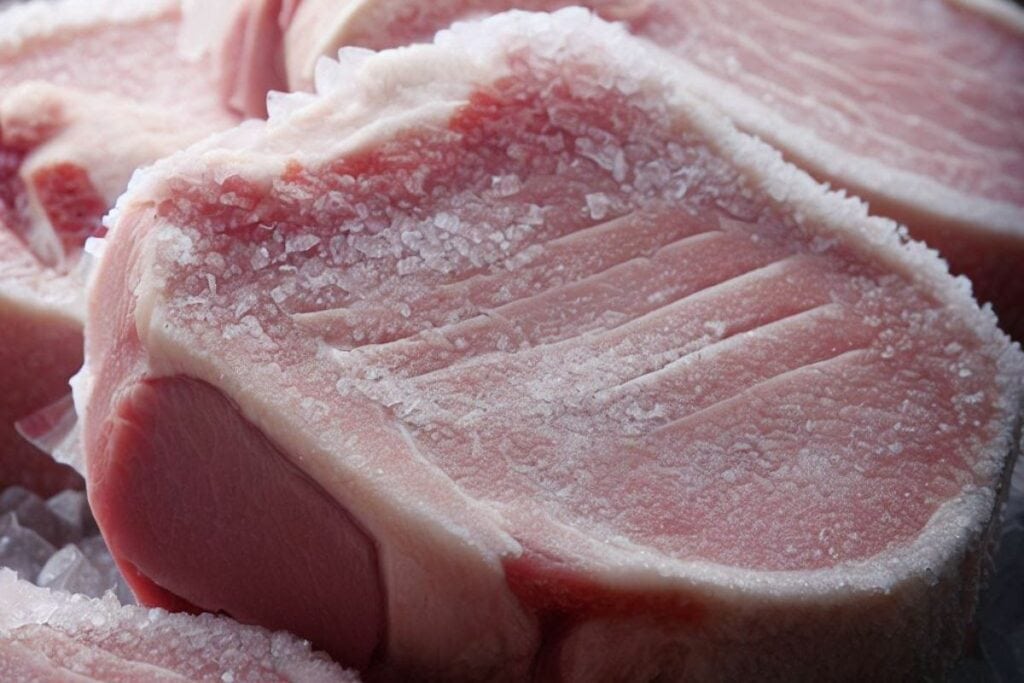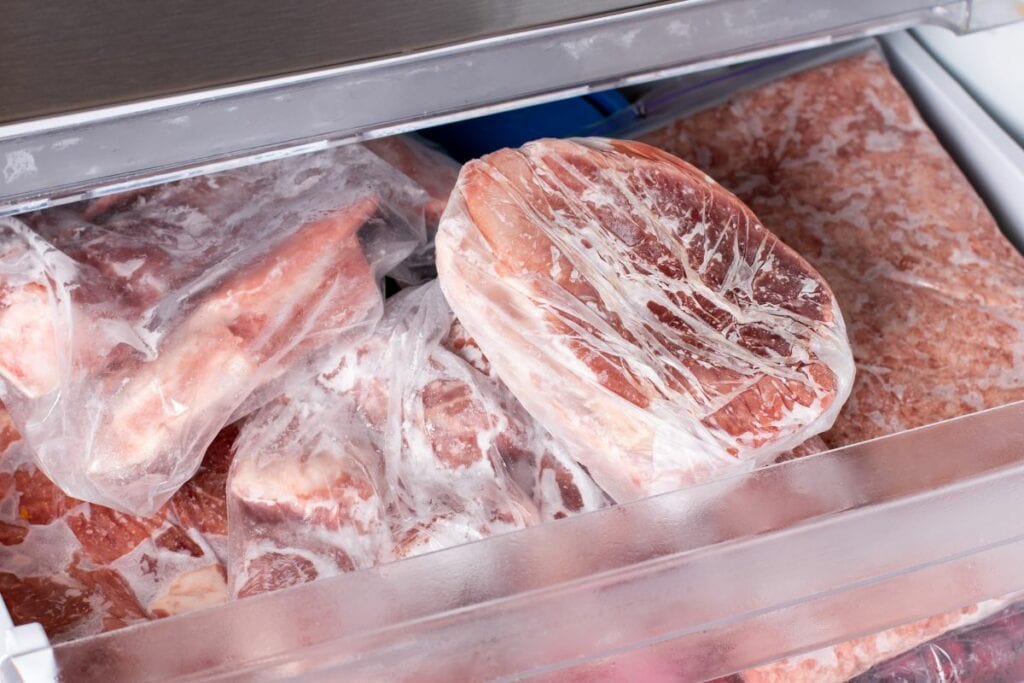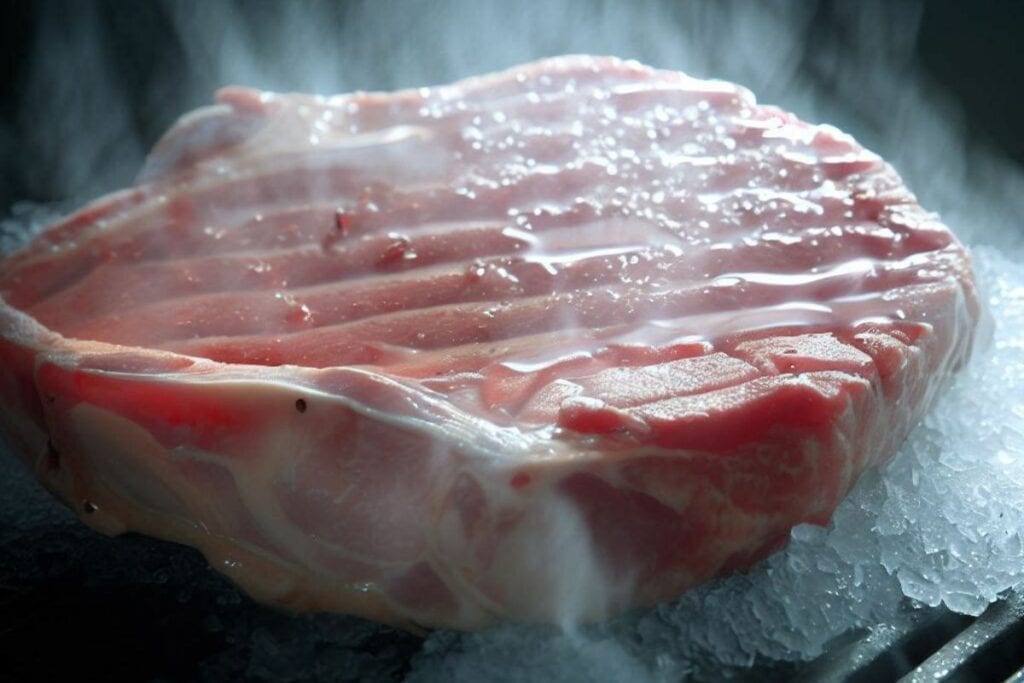You can defrost pork chops with three methods: cold water, a microwave, and a refrigerator. From experience, the easiest and most effective way to thaw pork chops is to use a refrigerator. Even though it is possible to cook your pork chops frozen, I don’t recommend this because your meat will likely come out unevenly cooked. There is also a question of some parts being burned.
But worry not, I’ll show you how to thaw frozen pork chops so you can cook them safely. I learned about food safety in cooking school, including the best methods to defrost pork chops. I’ve used all three of these defrosting methods with awesome results and taught some of my friends. So, without further ado, let’s get started!
Best Methods for Defrosting Pork Chops
Here are three of the best ways to thaw pork chops quickly:

Refrigerator
Thawing pork chops in the fridge is my go-to method. This method ensures that the meat thaws safely and completely. Defrosting in the refrigerator also requires minimal effort compared to the other methods.
Arrange the frozen pork chops on a plate or tray to catch the meat’s liquids as it thaws. Thaw the meat in the refrigerator for at least 12 hours and up to 24 hours. The total thawing time will vary depending on the thickness of the pork chops.
Remember to place the tray of frozen pork chops in the coldest part of the fridge. Also, try to limit the number of times you open and close the fridge door while the chops are defrosting.
Leaving the door open for a long time can cause the fridge’s temperature to drop, increasing the risk of bacteria multiplying on the meat. This is why I always recommend you place the meat in the fridge when you’re going to bed, allowing the chops to thaw overnight.

Cold Water
To defrost frozen pork chops with cold water, first, fill a bowl halfway with cold water. You can add ice cubes to the water to make it colder. When it comes to safely defrosting frozen meat, remember that temperature is everything.
Bacteria multiply more quickly at temperatures above 40°F. That’s why using cold water is so important, so the pork chop defrosts while maintaining a low temperature. Make sure you fill the bowl with enough water to completely submerge the meat.
Next, place the meat in a moisture-proof bag and submerge it in a bowl of cold water. Make sure the packaging is sealed well enough to keep water out. You’ll want to keep the water cold, so replace the water every 30 minutes and add more ice.
After the frozen pork chops thaw, remove them from the cold bath and cook them. Remember that you must cook the meat before you can refreeze pork chops.

Microwave
Using a microwave is the quickest way to thaw frozen pork chops. Unwrap the frozen pork chops and arrange them on a microwave-safe plate.
Make sure there’s about an inch of space between the chops and they don’t overlap. Set the microwave at the low or medium power setting and heat it for 2 minutes. You can also use the defrost setting if your microwave has this feature.
Flip the pork chops and cook them for another 2 minutes. Flipping the chops ensures they defrost evenly on both sides. Use tongs to flip over the meat so you don’t burn your hands. If the meat is still cold, continue flipping and heating it for 2 minutes until it is fully defrosted.
Remove the pork from the microwave-safe plate once it is completely thawed and prepare to cook the meat. Similar to the cold-water method, the pork chops can be safely refrozen after cooking.

What is the Danger Zone?
The danger zone is a temperature range that falls between 40 and 140 degrees Fahrenheit. This range favors the growth of bacteria. At lower or higher temperatures, the bacteria will struggle to multiply. That’s why it’s important to freeze your meat below this temperature and cook it above this temperature.
When preparing your pork chops, ensure they don’t stay out at room temperature for over two hours, or you risk your meat becoming unsafe to eat. When you buy your chops from the store, you can place them in a cooler filled with ice to lower the temperature and slow down the growth of the bacteria. If you don’t have a cooler with ice, that’s fine; simply toss the meat in the fridge or cook it immediately after you get home.
What Are Pork Chops?
Pork chops are meat cuts from a pig’s loin. The pork chop is a lean cut of pork from the area between the shoulder blade and the hip. Pork chops can be part of a balanced diet if eaten moderately and cooked in a healthy, fat-free manner.
These meat cuts also have a mild flavor and can be used in a variety of recipes. Moreover, they pair well with sauces and can be grilled, baked, broiled, braised, or pan-seared. That said, there are different types of pork chops, including:
- Rib chops: These have meat with the backbone and ribs attached. Rib chops are fatty and tender cuts with a succulent flavor. From experience, broiling, grilling, or pan-searing rib chops are the best ways to prepare them.
- Sirloin chops: These kinds of chops are lean and have little fat. Sirloin chops come from the hip of the pig and can have a tough texture. So, make sure you marinate and cook these juicy pork chops slowly.
- Blade chops: Blade chops are made up of a portion of the shoulder blade bone. These pork chop cuts are flavorful and inexpensive, but they require slow cooking techniques to get tender.
- Loin chops: Loin chops are cut from the mid-back portion of the pig and have a layer of fat that surrounds the pork. This pork chop cut is lean and can become tough if not cooked properly. For this reason, it’s best to marinate the meat before cooking to break down the muscle fibers. I also recommend cooking the meat with moist cooking techniques such as braising.

Tip for Defrosting Pork Chops
When defrosting your frozen pork chops, there are a few things to remember to guarantee the quality and safety of the chops.
- The first thing to remember is that you must not defrost the meat at room temperature because it promotes the growth of illness-causing bacteria. The danger zone ranges from 40 degrees to 140 degrees, and thawing pork chops on the counter exposes it to this temperature, putting you at risk of getting sick.
- Once pork chops are defrosted, they should be cooked immediately. Do not refreeze the chops that have been defrosted, as this can affect the texture and quality of the meat.
- Remember, frozen pork chops should not be thawed in hot or warm water because they may defrost unevenly.
- Furthermore, be cautious when thawing pork chops in a microwave. Thawing frozen pork chops in the microwave can cause a portion of the pork chop to reach the danger zone. Therefore, you must carefully monitor it and cook it right after you remove it from the microwave.
- It’s also important to know which section of the fridge to put your pork chops in. Ensure that you place the pork chop in the cold section of the fridge and confirm that your fridge is at 40 degrees or below.
- Another tip is to place the pork chops on their own shelf in the fridge, away from other foods. You should also clean any juices that have leaked from the pork chops because the juices can breed bacteria and contaminate other foods in the fridge.
- Finally, when working with raw meat, always wash your hands. Also, wash and clean the surfaces and utensils you use. This reduces the possibility of cross-contamination and the spread of bacteria.
How to Freeze Pork Chops?
It’s important to know how to freeze pork chops if you want to store them for later use. Your pork chops will last for up to six months in the freezer. First, make sure the pork chops are placed in an even layer and not stacked on top of one another.
This allows the chops to freeze evenly and quickly thaw as a result. Furthermore, the pork chops will spend less time in the danger zone thanks to this step. To prevent the pork chops from sticking together, place parchment paper between them. Moreover, make sure you push out all the air from the bag to preserve the quality of the chops.
Can You Cook Frozen Pork Chops?
You can cook frozen pork chops, but there are a few things to consider. Firstly, cooking frozen pork chops will take significantly longer. When exposed to heat, the meat will first begin to thaw before it starts cooking.
The other thing to note is that cooking frozen pork chops leads to uneven cooking. That’s why we thaw pork chops in the first place.
When you cook a frozen pork chop, some parts will begin to cook and finish cooking before others. This will create a problem as you cook because some sections will be cooked through while other sections get burned.

Best Way to Cook Defrosted Pork Chops
There are several tasty ways to prepare pork chops once they have been completely defrosted. Here are a few of my favorites:
- Slow Cooking: Cook your pork chop in a slow cooker for a low-effort, tasty dish. Cook on low for several hours, or until the pork chop is very tender. Remember to add your favorite seasonings to the pot.
- Grilling: Pork chops are a traditional BBQ dish that can be prepared with different condiments. Brush the meat with your preferred BBQ sauce or rub, and grill until moist and tender.
- Pan-searing: A pork chop can also be pan-seared for a crispy mouthfeel. You’ll need a cast-iron skillet for this. So, sprinkle salt and pepper on the steak and sear until crispy and done to your liking.
- Oven-Baking: For a quick and easy meal, you can bake pork chops in the oven. Season the chops with pepper and salt, and bake at a low temperature until the meat is cooked and tender.
Regardless of the method you use to prepare your thawed pork chops, the meat will come out delicious and tender. Remember to cook the meat to an internal temperature of at least 145 degrees to ensure that the pork is safe to eat.
Conclusion
That’s all for today! Knowing how to defrost pork chops safely is crucial to ensuring your meat is safe to eat. Whether you defrost pork in cold water, a microwave, or a fridge, make sure you follow the guidelines we discussed in the article. Remember to prevent your frozen meat from entering the danger zone and cook the meat immediately after it finishes thawing. Lastly, ensure your cooked pork chops reach an internal temperature of at least 145 degrees F.

